Hello World,
Update information :
- This procedure has been tested with the latest version of Proxmox VE 1.9 and it’s still working !
-
If you want to deploy Proxmox VE 2.0, You should use the procedure described at http://c-nergy.be/blog/?p=1628. The process is much simpler and faster. Proxmox VE 2.0 natively support installation from usb devices
In one of my previouspost about ProxMox VE , I mentioned that “at the moment” it is not possible to perform a ProxMox VE installation from a bootable usb sitck. Up to Version 1.7, there is no support for installing from a USB thumbdrive. This is quite disappointing ! Especially when you know that Vmware or Hyper-V can be installed quite easily from a USB Stick….
I came across this limitation during the re-installation of a test environment. I didn’t want to burn a new cdrom from the the ProxMox VE iso image. So, I thought that by using utility such as unetbootin, I would transfer the ISO image into a bootable USB Stick and perform the installation from the USB… Well not quite !
The USB drive will boot without any problem but the ProxMox VE installer will not start and your system will reboot… This behavior can be explained by the fact that the script used by the ProxMox VE installer checks only for CDROM devices. More information about this can be found on the ProxMox VE forums (see these links http://forum.proxmox.com/threads/4941-Install-Proxmox-VE-from-a-flash-disk ; http://forum.proxmox.com/threads/2932-proxmox-install-from-usb ; http://forum.proxmox.com/threads/1896-USB-Installation). At this point, we just need to find a way to have the system launching the setup routine even if no CDROM devices are detected.
Let’s try doing this right now !
Installing ProxMox VE from a USB Stick – Yes, you can !
After some tests (try and errors), I succeeded ( on 2 differents hardware configuration) to start the ProxMox VE installation from a USB Stick ! To perform the installation from the usb stick, you need to manually enter some commands from the terminal session. It might be possible to modify the init file and include the missing code to have the installer detecting USB devices and perform the installation from a USB Stick. But I think that the Team behind the ProxMox VE will probably integrate such capabilities in the next release.
So let’s go ! To perform your installation, you will need the following :
- Download the ProxMox VE Iso file from here
- Download a tool that will convert your usb stick into a bootable one (for example, unetbootin or usb universal installer)
- USB Stick with 1 GB of RAM (or 512 MB can still do it)
- a computer capable of booting from a Usb drive
Step 1 – Creating/configuring your Bootable Usb Stick
For this post, I was using a Windows machine and decided to give a try to the usb universal installer. You simply download the utility, double-click on the exe file and accept the license agreement. Within the application, you specify which drive letter is your USB Stick and where is located the ISO file you want to use. Note that I have choosen for the distribution the option “Unlisted Linux ISO”
You simply press create and you wait for the process to complete. At the end, if you explore the content of your usb stick, you will see something like this
This is the default file structure coming from the PROXMOX VE binaries.
Optional
To save on disk space, you can delete all the folders except the boot folder. Because we will be installing from an ISO image, we do not really need all these files. the boot folder contains what’s needed for the stick to boot in a minimal environment. So, my bootable USB stick looks like something like the screenshot below
Do not forget to copy your proxmox iso image at the root of the Usb stick (see above screenshot). At this stage, you should have a bootable USB stick and you should be ready to plug this stick into your computer that will be hosting the ProxMox VE software
Step 2 – Boot from USB in Debug mode
In this step, you simply boot your machine from the usb stick you have just prepared. If everything is correctly set, you will see the PROXMOX VE splash boot menu. Do not boot in normal mode.If you boot in normal mode, the system will reboot automatically because no cdrom device will be founded. Instead, boot in debug mode
To start in debug mode, simply type at the prompt : debug (see screenshot below)
click on the picture to enlarge
If you monitor the booting process, you should see that USB Mass storage devices are detected. You do not need to do anything at this stage. This is only informational. Wait for the boot process to complete
click on the picture to enlarge
When the boot process is completed, you will see a message similar to “no cdrom found – unable to continue (type exit or Ctrl-D to reboot)“
At that stage, you have access to a console where you can issue a set of commands.
If you have reached this point, you can move to step 3
Step 3 – Identify your usb device and mount it
Based on the hardware configuration, the Usb Device can be identified by the system differently. So, we will first need to identify how the usb device is recognized by the system. Because i have a limited set of command (I cannot use lsub), i’ll be using the old fdisk command.
From the console, I’ll simply type fdisk -l.
This command will return the disks and partition available on the system. From the screenshot below, I know that my usb drive is mapped as /dev/sdb1 (because my usb is 1GB in size). In your computer, this might be a different mapping. On my other system, the usb drive is mapped to /dev/sdd1. So, please check !
click on the picture to enlarge
Ok! So you have identified your usb device. We now simply need to mount this device. You can issue the famous mount command
mount /dev/sdb1 /mnt (note : the /dev/sdb1 represent my stick on my system — Please change this value to reflect your settings)
You can also check that the usb device is now mounted by simply typing mount (see screenshot below)
click on the picture to enlarge
Step 4 – Mount the ISO file and manually start the Installer routine (from the command line)
Almost there….. We now need to issue 2 additional commands and we are ready to perform the installation of the ProxMox VE from our usb stick….
The following screenshot shows you the command that needs to be run on the system to start the ProxMox VE Installer
First, we need to mount the iso image containing the ProxMox Ve binaries. This is quite straightforward. We simply need to issue the following command :
mount -o loop -t iso9660 /mnt/proxmox_1-7.iso /mnt (again change accordingly based the name of your iso file… )
To ensure that the mount operation succeeded and that a loop device is detected by the system, you can type again the command mount
Finally, we need to manually issue the command that will start the ProxMox Ve installer. From the console, you simply type
chroot /mnt sbin/unconfigured.sh
If everything works as expected, you should see the ProxMox VE installer (the GUI basically) and you can go through the wizard to perform your installation
Conclusions
This post explains in detail how to have a successful installation of ProxMox VE from a USB bootable drive. The procedure is not too complex and you just need to issue a bunch of command from the console. I really hope that the next release of ProxMox VE will take into account that more and more people are performing installation from Usb sticks. I hope that this post will be useful to other people out there using ProxMox VE
This procedure is working for me. I cannot guarantee that this will be working on all situation but you can give it a try 🙂
Till next time
see ya
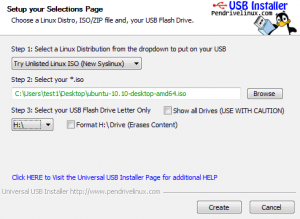
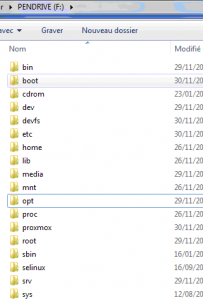
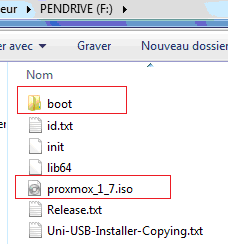
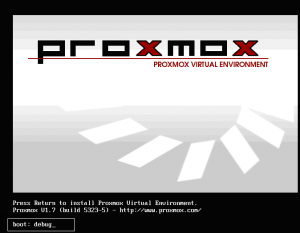
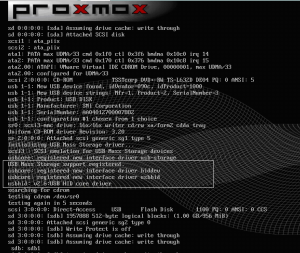
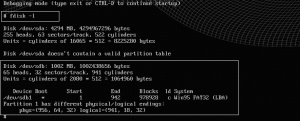
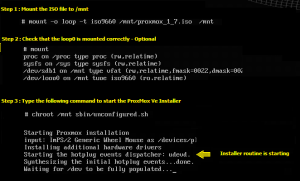
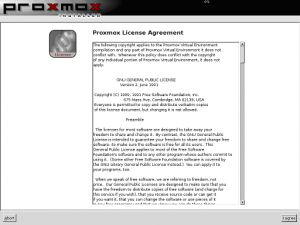
Hello Stoo;
Thank for the visit and the feedback. Tis always good to see that some posts are helpful
Stay tuned
Till next time
see ya
Sorry to tell this : I cannot not boot from USB do in your way!…
I use Win32DiskImager (https://sourceforge.net/projects/win32diskimager/) and its lot better !
Hello Khampol,
It’s fine with us. Please note that the post is outdated and the proxmox ve team has since provided a more convienent way to install from USB Stick. If you didn’t see it, there is a comment in the beginning of the post that redirect you to another post
Till next time
See ya
Updated instalation instruction:
– in BIOS enable CSM on UEFI boards and set it to Legacy mode
– in BIOS disable Secure Boot
– create USB Bootable device using Rufus tool (current verison 2.11.995) and download the latest Proxmox image (tested with pve v4.4)
– after starting copying, if it shows dialog with “Download requered”, select NO
– if it detects Hybrid image, submit “Write in DD Image mode”
– after the PC boots up, click on or for manual selecting USB device
– select “UEFI:portable memory stick” or something that starts on “UEFI: …” and is bootable
– install standard way, do not use DEBUG mode anymore !!!!!!
i can’t find unconfigured.sh
what can I do ???
j’ai un problème fatale avec le fichier unconfigured.conf , je recoie toujours un message d’erreur ‘No such file or directory”
merci de bien vouloir m’aider.
@Mouhssine,
Seriously ?
Please read carefully information posted in this blog… the post you referring is out dated and applies only to proxmox ve 1.x. Current version of Proxmox ve is 4.x. (or 5.x as beta version) At the very beginning of the post, there is a note. if you are using Proxmox ve 2.0 or later, there is another post…
Finally, If you go to the proxmox ve wiki pages, you will find all the necessary information to perform the installation (see https://pve.proxmox.com/wiki/Install_from_USB_Stick)
Till next time
See ya
@Mouhssine,
Seriously ?
Please read carefully information posted in this blog… the post you referring is out dated and applies only to proxmox ve 1.x. Current version of Proxmox ve is 4.x. (or 5.x as beta version) At the very beginning of the post, there is a note. if you are using Proxmox ve 2.0 or later, there is another post…
Finally, If you go to the proxmox ve wiki pages, you will find all the necessary information to perform the installation (see https://pve.proxmox.com/wiki/Install_from_USB_Stick)
Till next time
See ya
News flash Einstein the instructions from them you keep linking, and read this carefully, DOES NOT WORK
@Eric,
Sorry if the process didn’t work for you….Please not that this post is outdated and you might want to check on more recent source
Till next time
See ya
Tested this today and it doesn’t seem to work. Proxmox refused to recognize a USB disk as an installation target.
The VirtualBox approach still works well though. Just install to a virtual disk of a FIXED size (dynamic didn’t work for me) and then write it to a USB using Rufus.
The system booted up just fine with this. A quick change to /etc/network/interfaces for the real network interface name, a reboot, and it was up and running.
Thanks!
hey,
why is so hard to install from usb? i want to test this product and i spent 2 hours trying to install using a lot of ways to make an usb bootable.
@Claudiu,
For you info this post is really obsolete and outdated. An update post was published some time ago which is probably also out dated. Please check proxmox ve wiki and you will see that usb installer process is quite straight forward
Hope this help
Till next time
See ya
How to install proxmox in DL380 Gen10 HPE server machine ?? Please
@Edris,
Thank you for visiting our blog and providing some feedback. To answer your question, Please note the following…. the post were you left your comments is out dated. you have to look at this post http://c-nergy.be/blog/?p=1628 to get a more recent information about how to create a bootable usb disk. When you have the bootable usb disk, you an plug into your HP server, and boot from it….. The best place to get the latest info about creating bootable usb stick is to go to the Proxmox VE Wiki and can be found at https://pve.proxmox.com/wiki/Prepare_Installation_Media
If you have the Proxmox ve ISO, you can also use the Virtul media. To explain how to use virtual media, the easiest would be to redirect you to a youtube video 🙂
Please have a look at https://www.youtube.com/watch?v=csViwZFI3Y0 and give it a try
Hope this help
Till next time
See ya